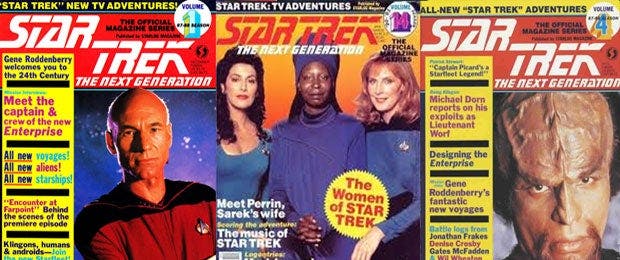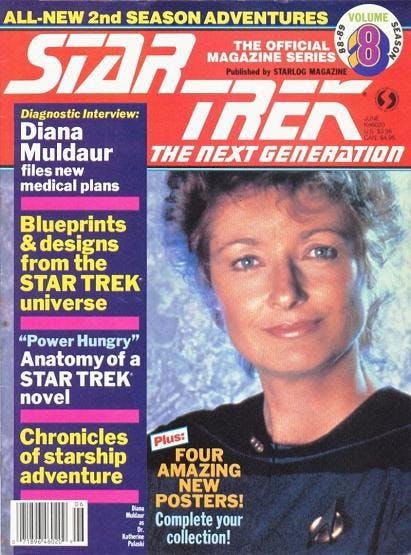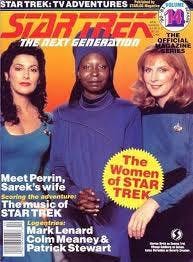Published Sep 21, 2013
Starlogging with David McDonnell: How To Synopsize The Next Generation
Starlogging with David McDonnell: How To Synopsize The Next Generation


Starlog's Official Next Generation Magazine, that is. It was difficult to fill the new publication (edited by me) with enough feature stories. Due to the demands of making the show during that first season and the limits early on regarding possible interviewees, we couldn’t actually include 10-12 interviews every issue. Something else had to, well, occupy the space.
That something was a synopsis of each episode. Now, amazingly, several readers later told me at SF conventions that these mini-novelizations were their favorite parts of the Official Trek Magazines. Why? Because reading synopses enabled them to "relive the episode" without the trouble of pulling out a tape and firing up the VCR. Yes, I was flabbergasted by this, too.
My stable of synopsizers included three ex-Starlog staffers (Robert Greenberger, Patrick Daniel O’Neill, my first managing editor-turned-relocated-freelancer Carr D’Angelo), paperback novelist Will Murray and my old Bethany College pal John Sayers (then the managing editor of a video technology newsletter). It was their formidable task to transform each Trek teleplay into a short story of 1800-2500 words, including crucial dialogue and translating stage directions into exciting action passages.
As they became available, Paramount Licensing would provide me with each Next Generation script. I’d pass on a copy to the assigned writer who would do his adaptation. The result would be copy-edited by my managing editor, then by me. After typesetting and proofreading by multiple staffers, the story would be submitted to Licensing for approval.

But, much as it pains me to admit it, he had a point about accuracy. We worked from the studio-provided teleplays, but they weren’t necessarily final. Scenes could be dropped or shifted, lines altered for the edited broadcast version. There were certainly occasions when the three crewmen noted in the script (and therefore our faithful synopsis) became just two on screen (to decrease expenses?) or a mist colored orange on the page faded to grey (or gray) on TV. So, I made it our mission to make the Trek synopses as accurate as possible just because we could. We wouldn’t rely merely on the scripts; I personally would check our work against the broadcast.
My initial team of synopsizers soon shrunk. D’Angelo did only one or two entries before exiting (crafting short stories wasn’t his cup of Earl Grey).He landed a job at Universal Pictures in Los Angeles, becoming a studio executive (who supervised Dazed and Confused, Happy Gilmore, etc.) and later a movie producer (The Animal, The Hot Chick). These days he has found his first, best destiny, happily co-owning several comic book shops in Southern California.
Freelancer O’Neill was hired as an editorial staffer by a new publication: Wizard (which covered comic books and their creators). Since it was direct competition for our Comics Scene (a magazine also edited by me), that move made it impossible to keep him synopsizing Trek.

Greenberger eventually departed, too. He was busily editing DC Comics’ licensed TOS and Next Generation comic books. In later years, he wrote Trek novels for Pocket Books, including The Romulan Stratagem, A Time to Love, Slings and Arrows, A Time to Hate and several collaborations with Peter David and Michael Jan Friedman. He’s the only person who has undertaken all three basic Trek missions: interviewed personalities (for Starlog), edited comics and written books. No scripts for a Trek TV show yet, but there’s still time.
Murray stayed on but became only a sporadic synopsizer for Next Generation and our subsequent official magazine series devoted to DS9 and Voyager (both also, natch, edited by me). When he had the time, I mostly wanted Murray visiting movie sets and doing comics/pulp history pieces. Otherwise, he was occupied with writing paperbacks. At one point, he was contracted to ghost write four novels in The Destroyer series annually (while also delivering three new Doc Savage books a year). Savage is a quintessential pulp magazine hero who influenced such later creations as Superman, Batman, James Bond and the Fantastic Four. Today, Murray is back writing Savage exploits. His latest, Skull Island, pits Savage (whose NYC HQ was the Empire State Building) in an authorized encounter with the ESB’s most famous social climber, King Kong. It’s available in trade paperback and ebook editions. See the websites www.adventuresinbronze.com and www.altuspress.com.
In for the long haul was Sayers who, for the remaining years of our three Trek magazines, wrote all other "Mission Report" synopses (200 plus). He got extraordinarily good at it. Inadvertently, Sayers also got extra credit. That’s because each synopsis included the episode’s official, often-complex on-air writing credits (scrupulously checked by me and confirmed by Paramount) as well as a byline indicating the adaptation’s author ("Synopsis by JOHN SAYERS"). One Trek reference, employing our magazines as the source for all writing credits, mistakenly added Sayers to an episode’s actual script credits in their database. Oops!
I became more accomplished at editing the synopses, too. Over the years, I went from doing the editing-for-accuracy pass while watching a videotape days after broadcast to literally editing it "live" as the show aired on local TV. I was aided by a tape recorder (so I could quickly playback any dialogue I was uncertain of during commercial breaks). And soon I was able to edit each and every synopsis for an hour Trek in just 70 minutes.
Talk about warp speed.
________________
David McDonnell, "the maitre’d of the science fiction universe," has dished up coverage of pop culture for more than three decades. Beginning his professional career in 1975 with the weekly "Media Report" news column in The Comic Buyers’ Guide, he joined Jim Steranko’s Mediascene Prevue in 1980. After 31 months as Starlog’s Managing Editor (beginning in October 1982), he became that pioneering SF magazine’s longtime Editor (1985-2009). He also served as Editor of its sister publications Comics Scene, Fangoria and Fantasy Worlds. At the same time, he edited numerous licensed movie one-shots (Star Trek and James Bond films, Aliens, Willow, etc.) and three ongoing official magazine series devoted to Trek TV sagas (TheNext Generation, Deep Space Nine, Voyager). He apparently still holds this galaxy’s record for editing more magazine pieces about Star Trek in total than any other individual, human or alien.
Copyright 2013 David McDonnell

